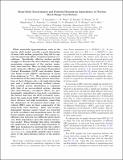| dc.contributor.author | Cruz Torres, Reynier | |
| dc.contributor.author | Lonardoni, D. | |
| dc.contributor.author | Weiss, R. | |
| dc.contributor.author | Piarulli, M. | |
| dc.contributor.author | Barnea, N. | |
| dc.contributor.author | Higinbotham, D. W. | |
| dc.contributor.author | Piasetzky, E. | |
| dc.contributor.author | Schmidt, Axel William | |
| dc.contributor.author | Weinstein, L. B. | |
| dc.contributor.author | Wiringa, R. B. | |
| dc.contributor.author | Hen, Or | |
| dc.date.accessioned | 2021-02-02T16:41:24Z | |
| dc.date.available | 2021-02-02T16:41:24Z | |
| dc.date.issued | 2020-11 | |
| dc.date.submitted | 2019-09 | |
| dc.identifier.issn | 1745-2473 | |
| dc.identifier.issn | 1745-2481 | |
| dc.identifier.uri | https://hdl.handle.net/1721.1/129626 | |
| dc.description.abstract | While mean-field approximations, such as the nuclear shell model, provide a good description of many bulk nuclear properties, they fail to capture the important effects of nucleon–nucleon correlations such as the short-distance and high-momentum components of the nuclear many-body wave function1. Here, we study these components using the effective pair-based generalized contact formalism2,3 and ab initio quantum Monte Carlo calculations of nuclei from deuteron to 40Ca (refs. 4–6). We observe a universal factorization of the many-body nuclear wave function at short distance into a strongly interacting pair and a weakly interacting residual system. The residual system distribution is consistent with that of an uncorrelated system, showing that short-distance correlation effects are predominantly embedded in two-body correlations. Spin- and isospin-dependent ‘nuclear contact terms’ are extracted in both coordinate and momentum space for different realistic nuclear potentials. The contact coefficient ratio between two different nuclei shows very little dependence on the nuclear interaction model. These findings thus allow extending the application of mean-field approximations to short-range correlated pair formation by showing that the relative abundance of short-range pairs in the nucleus is a long-range (that is, mean field) quantity that is insensitive to the short-distance nature of the nuclear force. | en_US |
| dc.description.sponsorship | US Department of Energy Office of Nuclear Physics (Award DE-FG02-94ER40818, DE-FG02-96ER-40960, DE-AC02-06CH11357, DE-AC05-06OR23177 and DE-SC0013617) | en_US |
| dc.language.iso | en | |
| dc.publisher | Springer Science and Business Media LLC | en_US |
| dc.relation.isversionof | http://dx.doi.org/10.1038/s41567-020-01053-7 | en_US |
| dc.rights | Article is made available in accordance with the publisher's policy and may be subject to US copyright law. Please refer to the publisher's site for terms of use. | en_US |
| dc.source | Prof. Hen via Barbara Williams | en_US |
| dc.title | Many-body factorization and position–momentum equivalence of nuclear short-range correlations | en_US |
| dc.type | Article | en_US |
| dc.identifier.citation | Cruz-Torres, R. et al. "Many-body factorization and position–momentum equivalence of nuclear short-range correlations." Nature Physics (November 2020): dx.doi.org/10.1038/s41567-020-01053-7. © 2020 The Author(s) | en_US |
| dc.contributor.department | Massachusetts Institute of Technology. Department of Nuclear Science and Engineering | en_US |
| dc.contributor.department | Massachusetts Institute of Technology. Department of Physics | en_US |
| dc.relation.journal | Nature Physics | en_US |
| dc.eprint.version | Author's final manuscript | en_US |
| dc.type.uri | http://purl.org/eprint/type/JournalArticle | en_US |
| eprint.status | http://purl.org/eprint/status/PeerReviewed | en_US |
| dc.date.updated | 2021-01-27T14:54:25Z | |
| dspace.orderedauthors | Cruz-Torres, R; Lonardoni, D; Weiss, R; Piarulli, M; Barnea, N; Higinbotham, DW; Piasetzky, E; Schmidt, A; Weinstein, LB; Wiringa, RB; Hen, O | en_US |
| dspace.date.submission | 2021-01-27T14:54:32Z | |
| mit.license | PUBLISHER_POLICY | |
| mit.metadata.status | Complete | |
